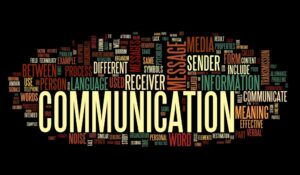3 Keys to Effective Communication


“The art of communication is the language of leadership.” – James Humes
By: Jordan Warshafsky While the world of life sciences and biotechnology is exciting and challenging, it is also demanding. Leading a team of highly qualified professionals can be tricky. After all, they didn’t reach their position without a lot of hard work, intelligence, and self-motivation. The key is tapping into those unique skills and vast experience, and encouraging creative innovation, while still maintaining your role as a leader/manager.
Healthy leadership begins with establishing an open, mutually respectful relationship with your team. Healthy relationships are built on effective communication. Three keys to effective communication include:
Active Listening
One of the single most critical elements of communication is listening. It lays the foundation for all aspects of communication. Active listening begins with self-awareness. Understanding your communication style will help you develop it and use it effectively, creating positive impressions with others. But that is only one side of the coin. It is equally vital to learn about other communication styles and listen/respond to various individuals. Don’t let your personal filters, judgments, and beliefs distort someone’s message. Recognize diversity and draw from it.
Communication goes beyond words. Be intentional about listening not only to words, but also to the complete message. Facial expressions, body language, and what is not being said, are all part of communication. Acknowledge that you are actively listening to what they are sharing by smiling, nodding, and other your body language. For example, a relaxed pose with arms by your side indicates you are focusing your time on listening, and you are open to what they have to say. On the other hand, a defensive, agitated stance and crossed arms conveys that you don’t have time, and you do not want to hear their message.
Ensure that you understand their message. Clarify accurate reception by repeating back what you are hearing. Paraphrase, “What I’m hearing is . . .” Ask pertinent questions. Give the speaker your full attention. Put aside distractions. Listen and absorb before you answer – don’t be formulating your thoughts when you need to be listening. Refrain from interruptions. It only frustrates the speaker, detours their point, and limits your understanding. Listen, pause to absorb, and then ask questions. Even if the end result is that you represent an opposing view, respectfully listening to what they have to say, and understanding the basis of their point of view, will encourage them to do likewise. Furthermore, you may both walk away with a more rounded outlook.
Feedback
Another angle of communication is feedback. As a manager/leader, you will need to provide feedback – from basic policies and procedures to detailed research, testing, methodologies, etc. In some situations, it will involve constructive criticism. An essential key to effective feedback is consistency. When you communicate with your team consistently, you create unity and understanding, and establish performance expectations. If everyone is on the same page, you will be better prepared to deliver the necessary feedback when a negative situation arises, and they will be better ready to receive it.
We live in an instant messaging world, but when delivering feedback, talking face-to-face is vital. Even if you are conducting a tele-meeting, choose a platform that allows for face-to-face. Written communication (for constructive feedback) is far too open to misinterpretation because it eliminates vocal tone, facial expression, body language, and emotional inflection – all crucial elements of communication. Remember to balance the negative with the positive. Recognizing and affirming what is rightly being accomplished sets the stage for the reception of corrective comments.
Present the actions you have observed, requesting – and then listening – to the perspective that motivated those choices; it will provide you with a clear picture and maintain a mutually respectful relationship. Pinpoint the topic or angle you are discussing. Do everything you can to increase understanding and present viable solutions. Finally, do not make your constructive feedback personal. Each team member was chosen for their knowledge, skills, and experience – they play a valuable role. If an issue needs to be addressed, discuss the issue. Do not tie the character and value of the person to the problem.
Conflict Resolution
Conflict Resolution is another responsibility that will fall on you as a manager. Your life sciences or biotechnology team reached their position because of their strength and insight, as well as their knowledge and experience. Inevitably this will lead to diverse approaches, thoughts, methods, etc., and may create conflict. Being able to resolve this conflict is perhaps one of the most challenging aspects of effective communication.
Clarify the source of the conflict. Don’t point fingers or become defensive. Help those involved to get to the root issue and deal with it. Listen actively to everyone involved. Provide individuals a safe and private place to share their perspectives and voice their concerns. Don’t jump too quickly to a conclusion. Investigate. Take time to dig deeper, research points made for accuracy, and discern misunderstandings or outside factors influencing the conflict.
Set the pace with your actions. Remain calm and respectful. Avoid gossip—place value on everyone’s perspective. Bring the team members together. Encourage compromise and collaboration. Help each one gain understanding of other views. Define your common goal and ways to come together. Accept input from everyone involved and encourage an appropriate solution. Establish each one’s responsibilities for moving forward, including preventative strategies for the future.
Summary: As the life sciences or biotechnology team leader, your communication skills will play a vital role in defining your leadership. Learn to recognize both your communication style and the style of team members. Be an active listener and refine your feedback skills –particularly when delivering constructive criticism. Hone your conflict resolution abilities, and set the pace for a united team by your words, actions, and demeanor.
Finding strong leadership and building effective teams who communicate well takes time. Ashton Tweed is a boutique retained search firm. We specialize in finding the talent your company needs – for both long-term and interim placement. Contact us today.





